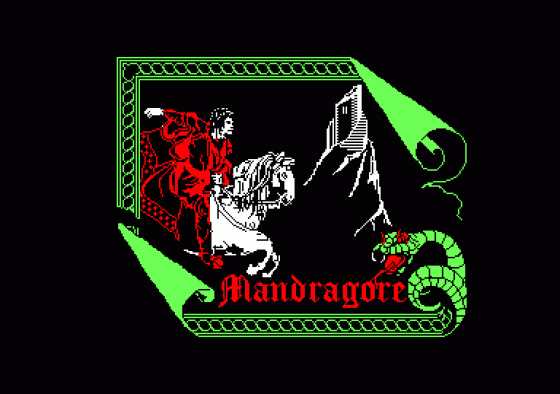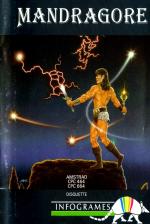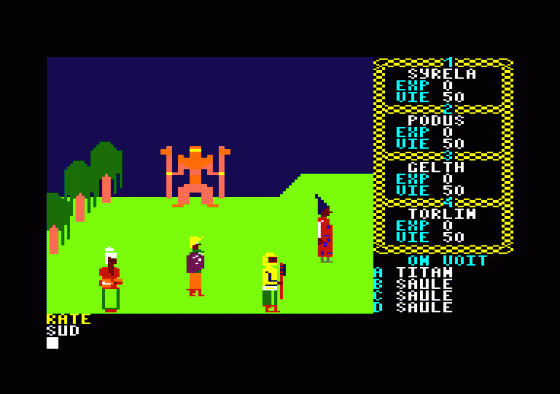
Amstrad Action
 1st September 1986
1st September 1986
Categories: Review: Software
Author: The Pilgrim
Publisher: Infogrames
Machine: Amstrad CPC464
Published in Amstrad Action #12
Mandragore
'Twas only a few weeks back that a younger and less experienced Pilg penned the following immortal lines:
'Brill graphics and some truly original gameplay. Mandragore promises 250K of adventure, up to four players, and a ten chapter 'booklet' for £14.95. I reckon this could be a very impressive petit gamette, so watch this space.'
Well, here's the space to watch, here's the game up on my Amstrad, and here's my initial reaction...

Ugh!
Okay, okay, if there's anyone from Infogrames reading, don't have a heart attack. I'm not going to slam the game - in fact, I quite like it - but the problem is that it just doesn't look too good. The gameplay is fine, but the graphics certainly don't impress at first sight and may well have the effect of putting a few people off altogether. Let's delve a little further into the game and see what we have.
Mandragore is a role-playing game for up to four players. That means that each player creates a character and allocates it specific values for intelligence, wisdom, and so on. You then sally forth and explore the world of Mandragore; doing battle with monsters, finding treasure, exploring castles and trying to stay alive.

The point of the characterisation is that, in theory, your attributes should determine the manner in which you play the game. If you play on your own you can create four different characters and control them all yourself. A group of characters is called a ream and its success or failure depends to a certain extent on the manner in which the different team-members play together and use their respective abilities.
A character may belong to one of five different races: Dwarf, Elf, Mi-Ore, Obbit (i.e. Hobbit), or Human. In Mandragore, each character possesses six attributes - constitution, strength, intelligence, wisdom, dexterity, and appearance. The last struck me as being a bit odd until I realised that it meant 'charisma' - a lesser-known but fairly traditional role-playing attribute that (I think) basically determines how likely you are to sweet-talk the next Balrog.
When you determine the attributes of your character, you are given 80 points to distribute, and must allocate between five and 20 points to each attribute. During the game two other attributes, Experience and Life, come into play. The first simply increases as you solve puzzles, find treasure, or defeat monsters; the second starts at 50 points and decreases in battle or strenuous exertion (attempting to open locked doors, for example). Once its life points reach zero a character dies, and life points can only be increased by eating or by casting one of the few spells available (such as cure).

So much for 'team creation'. One of the nice things about Mandragore (especially nice for disc owners) is that you can SAVE a team at any time during play, to resume later on where you left off. If you wanted to, you could use this option to create different teams with different qualities, SAVE them right at the start of the game and then run through the game with each one to see how the different attributes affected gameplay. More about this later.
On to the actual gameplay itself. Mandragore has four basic 'modes' of play. The first is 'MAP' mode. In this mode you see a fairly crude representation of the surrounding terrain. A small figure in the middle of the screen represents the position of your team and you can move about by entering commands at the keyboard.
The whole command structure is rather complex at first glance, but is in fact very simple to master. There are about 30 verbs allowing you to instruct your character(s) to perform actions such as INSPECT (an object), PARALYSE (a monster), BARTER (exchange cash or food for goods) and so on. Compared with other games of this type (and there aren't many on the Amstrad) this is quite a creditable range of options. You enter them by typing the first two or three words, and the parser then completes the command for you appropriately.
In giving commands you will of course have to specify the character and in some cases the object, person, or monster involved, as in SYRELA ATTACK TICKEL WITH KNIFE. All the characters have a number for use in this instance, as do all objects carried. Objects and monsters in view at the time have a code letter displayed on the side of the screen for reference purposes. You soon get used to it and, in conjunction with a 'repeat command' option, it can speed things up no end - very useful when repeatedly attacking someone.
Whilst in MAP mode you can wander around and the landscape scrolls appropriately. From time to time you are confronted by a monster which throws you into 'Wandering Monsters' mode. The screen clears and shows you the immediate location complete with resident nasty (or nasties). You must then either vanquish the opposition or flee, which you can do by pressing M to change back into MAP mode - but this carries a heavy penalty of ten life points for each character.
Alternatively, you may come across a village or chateau (this is a-French game, remember). Chateaux are the key to the game. They hold treasure, puzzles, weapons, food, and (of course) monsters. Chateau mode is entered by moving in MAP mode to a Chateau symbol and then pressing C. You must then load the relevant data for that Chateau from disc or tape.
As you explore the Chateau each location and its contents are displayed on screen. The same happens in Village mode, which is entered in a similar manner from Map mode (though you don't have to load a separate data file). Villages are generally a far safer place, and give you the opportunity to trade and replenish your supplies. There isn't a lot of point, however, in making for a village until you've ransacked a nearby chateau for treasure.
So what's it like to play? Well, once you get over the disappointment of the graphics, it's really not too bad. The only competitor that I can think of is Ring Of Darkness from Wintersoft (now a bargain on Global's Fourmost Adventures collection) but the scale of Mandragore is of course far greater. The chateaux are all very different from one another and some of them pose extremely difficult puzzles indeed; quite apart from the hazardous business of defeating their inmates. But after a while you work out which actions do most to increase your character's experience, and where to find food and weapons.
Apart from the graphics, my other major quibble with the game is the lack of detail in the different situations. There is only one line available for the program's textual responses on the screen, and 'Inspecting' objects usually gets a curt response like 'No danger' or 'Booby trapped', but not much else. This being the case the weakness of the graphics, and in particular the pathetic way in which the characters move about the screen, becomes even more disappointing.
Finally, it's not altogether clear during the game to what extent each of your carefully chosen character attributes are having any effect. Experience seems to count for quite a bit, so it's worth taking note of the particular situations which increase it most; and I noticed that the Thief was better than others at stealing - but then that's an obvious one. However, to really pass judgement on this side of the game you would have to play for a very long time, and it's to the credit of the game that I think I'll probably be making time to do just that.
But then I've got a free review copy! Should you go out and actually buy it? At £14.95 it's not cheap, certainly. It doesn't look like a program that's worth anything like that amount. However there's a fair amount of monster bashing here and, although there aren't that many chateaux to explore, I reckon that together they offer sufficient variety to keep you busy for some time. And of course there are all the villages and wandering monsters in between.










